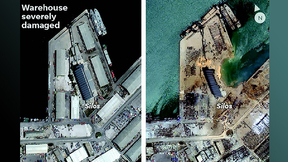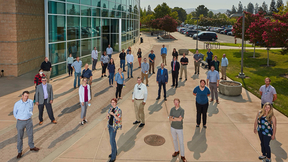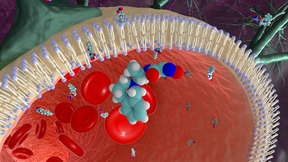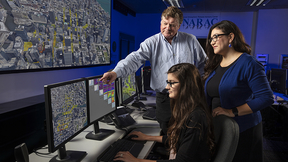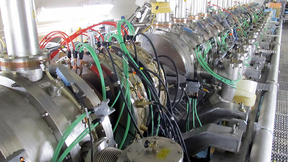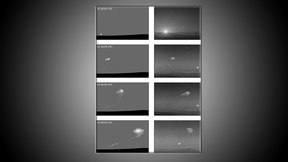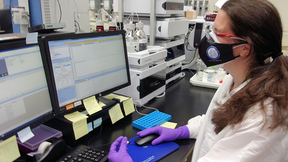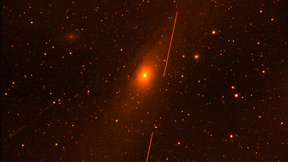Back
Global Security
Making it count: Rebuilding infrastructure at the Nuclear Counting Facility
When Daniel Martin put the finishing touches on an autonomous vehicle robot, complete with an ultrasonic sensor to detect and evade obstacles, he knew he wanted to become an engineer. A high school student at the time, he was fascinated by the design and functionality of robots. Fast forward several years, and Martin is now a second-year electrical engineering Ph.D…
Just how big was the 2020 Beirut explosion?
On Aug. 4, 2020, one of the largest non-nuclear explosions in history pulverized a Beirut port and damaged more than half the city. The explosion resulted from the detonation of tons of ammonium nitrate, a combustible chemical compound commonly used in agriculture as a high-nitrate fertilizer, but which can also be used to manufacture explosives. Since that time, the…
Late-time small-body disruptions can protect the Earth
If an asteroid is determined to be on an Earth-impacting trajectory, scientists typically want to stage a deflection, where the asteroid is gently nudged by a relatively small change in velocity, while keeping the bulk of the asteroid together. A kinetic impactor or a standoff nuclear explosion can achieve a deflection. However, if the warning time is too short to stage a…
Lab garners five technology commercialization grants
Lawrence Livermore National Laboratory (LLNL) scientists and engineers have posted another banner year securing major grants through the Department of Energy’s (DOE) Technology Commercialization Fund (TCF). “I think the Laboratory did very well again, reflecting a variety of types and approaches to our research and development projects,” said Rich Rankin, the director of…
R-cubed: Revolutionizing the present, anticipating the future
The Post-Detonation Rapid Response Research Venture — also known as R-cubed or R3 — is combining basic research and development of emergent technologies, predictive capabilities and systems assessment to revolutionize the speed and flexibility of technical nuclear forensic (TNF) response to nuclear events. The venture is a multi-laboratory collaboration led by Lawrence…
Lawrence Livermore develops promising antidote for nerve agent exposure
Scientists at Lawrence Livermore National Laboratory (LLNL) have developed a new, versatile antidote to counteract exposure to nerve agent poisoning. The work, appearing in the journal Scientific Reports, was the result of a highly iterative process built in collaboration between LLNL’s Global Security Directorate, its Forensic Science Center and the U.S. Army Medical…
The institutional response to 9/11 – with 'our track shoes on'
Editor's note: The following is part of a series of articles looking back at the Lab's response immediately following the Sept. 11 attacks and our contributions since that day 20 years ago. Lawrence Livermore National Laboratory’s (LLNL) “response” to the tragic events on Sept. 11, 2001, actually began in July 1992 with the formation of the Nonproliferation, Arms Control…
NARAC at forefront in a post-9/11 world
Editor’s note: The following is part of a series of articles looking back at the Lab's response immediately following the Sept. 11 attacks and our contributions since that day 20 years ago. From keeping Americans safe at national events to assisting with international disasters, Lawrence Livermore National Laboratory’s (LLNL) National Atmospheric Release Advisory Center …
How BASIS grew into the BioWatch system
Editor's note: The following is part of a series of articles looking back at the Lab's response immediately following the Sept. 11 attacks and our contributions since that day 20 years ago. Less than a month after 9/11, 14 Lawrence Livermore National Laboratory (LLNL) employees received calls at their homes at 1 a.m. on a Saturday morning (Oct. 6, 2001) and were asked to…
Diagnostic capability allows scientists to create X-ray movies
Lawrence Livermore National Laboratory (LLNL) scientists are working on a new diagnostic capability that will provide, for the first time, the ability to make X-ray radiographic movies. The first experiment testing the principle, dubbed the Bipolar Reset Experiment (BIRX), was conducted at LLNL’s Flash X-Ray (FXR) deep-penetration radiographic facility at Site 300. The…
Lawrence Livermore team captures data from unarmed Minuteman III test launch
A team from Lawrence Livermore National Laboratory (LLNL) successfully collected data from the recent operational test of an Air Force Global Strike Command unarmed Minuteman III intercontinental ballistic missile (ICBM) launched from Vandenberg Space Force Base. The purpose of the ICBM test launch program is to validate and verify the safety, security, effectiveness and…
Lawrence Livermore team captures data from unarmed Minuteman III test launch
A team from Lawrence Livermore National Laboratory (LLNL) successfully collected data from the recent operational test of an Air Force Global Strike Command unarmed Minuteman III intercontinental ballistic missile (ICBM) launched from Vandenberg Space Force Base. The purpose of the ICBM test launch program is to validate and verify the safety, security, effectiveness and…
Simulating nuclear cloud rise anywhere, anytime
For decades, understanding the behavior of a nuclear mushroom cloud was done with careful analysis of observations made during the testing era. Old photos, outdated film and incomplete weather data made precise calculations difficult. Now, with results published in Atmospheric Environment, Lawrence Livermore National Laboratory (LLNL) scientists are improving our…
LLNL earn 'A' grade in OPCW biomedical proficiency test
It wasn’t an easy road, but Lawrence Livermore National Laboratory (LLNL) Forensic Science Center scientists earned an “A” grade in the Organisation for the Prohibition of Chemical Weapons’ (OPCW) recent biomedical proficiency test. In addition to the usual complexity of the sample preparations and analysis, the Livermore scientists received their proficiency test samples…
Bradley Wallin selected to lead Weapons and Complex Integration
Bradley Wallin has been named Lawrence Livermore National Laboratory’s (LLNL’s) principal associate director (PAD) for Weapons and Complex Integration (WCI), Lab Director Kimberly Budil announced today. In this role, Wallin will lead the Laboratory's nuclear weapons program in its responsibilities to support U.S. strategic deterrence by assuring the safety, security and…
LLNL and KCNSC team up to accelerate design-to-deployment with new polymer production enclave
A polymer production enclave, in partnership with the Kansas City National Security Campus (KCNSC) and Lawrence Livermore National Laboratory (LLNL), is on budget and on schedule to bring modern technology into the Nuclear Security Enterprise. The enclave will enable rapid development of design and production processes of polymer parts for modernization programs. This…
LLNL and KCNSC team up to accelerate design-to-deployment with new polymer production enclave
A polymer production enclave, in partnership with the Kansas City National Security Campus (KCNSC) and Lawrence Livermore National Laboratory (LLNL), is on budget and on schedule to bring modern technology into the Nuclear Security Enterprise. The enclave will enable rapid development of design and production processes of polymer parts for modernization programs. This…
Nuclear forensics international group holds 25th anniversary meeting
Several Lawrence Livermore National Laboratory (LLNL) scientists played key roles in the 25th annual meeting of the Nuclear Forensics International Technical Working Group (ITWG), which met last month. The event, which was conducted in a virtual setting for the first time, was attended by more than 100 experts from 30 countries and highlighted the group’s notable…
LLNL’s Tactically Responsive Launch-2 payload launched into orbit
When the U.S. Space Force’s Tactically Responsive Launch-2 (TacRL-2) mission launched from Vandenberg Space Force Base on June 13, it carried a payload designed and built in record time by Lawrence Livermore National Laboratory (LLNL). LLNL provided a three-mirror reflective telescope and sensor for the payload, which they designed, integrated, tested and delivered within…
LLNL/Tyvak space telescope goes into orbit
Thousands of images of Earth and space have been taken by a compact space imaging payload developed by Lawrence Livermore National Laboratory (LLNL) researchers and its collaborator Tyvak Nano-Satellite Systems. Known as GEOStare2, the payload has two space telescopes that together have taken more than 4,500 pictures for space domain awareness, astronomy and Earth…



